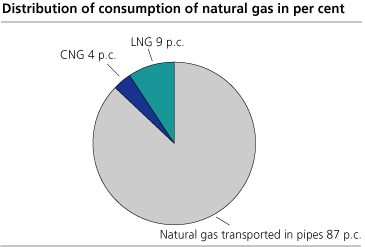Content
Published:
This is an archived release.
Increased domestic use of natural gas
Domestic use of natural gas is increasing and came to 217 million Sm3 last year, equivalent to 2 422 GWh. This is the highest figure ever and 6.9 per cent higher than in 2000. Almost 90 per cent of the natural gas consumption in 2003 was used in the manufacturing industries.
Data on the consumption of natural gas in Norway has been collected and used in the energy accounts and energy balance since 1994. More detailed information on sales of natural gas was collected in 2003 and for the first time this is published as a separate statistics. Liquefied Petroleum Gases (LPG), i.e. gases that consist of propane and butane, are not included here. LPG and other energy bearers are described in the Energy accounts and energy balance .
Although the use of natural gas is increasing it still makes up a small part of the total domestic use of energy. Last year only 1.1 per cent of the total net consumption of energy was natural gas and the share in 2000 was 1.0 per cent.
Transport in pipelines most common
Natural gas can be transported in pipelines, as liquefied natural gas (LNG) or as compressed natural gas (CNG). In 2003, 189 million Sm3, or 87 per cent, of the total net domestic use of natural gas was delivered in pipelines. Some 20 million Sm3 was delivered as LNG and 8 million Sm3 as CNG. 98.5 per cent of the deliveries of natural gas to the manufacturing industries was delivered in pipelines.
Manufacturing industries largest consumer
The consumption of natural gas in the manufacturing industries amounted to 195 million Sm3 in 2003. This represents 89.9 per cent of the total net consumption of natural gas in Norway. The consumption of natural gas was clearly highest in the manufacture of chemicals and plastic products, at 151 million Sm3 in 2003. The consumption of natural gas was also high in the manufacture of basic metals, at 23 million Sm3. In the manufacture of food products the consumption was 10 million Sm3, while other manufacturing industries used 5 million Sm3. With the exception of the manufacture of pulp, paper and paper products, most of the natural gas is delivered in pipelines. For the manufacture of pulp, paper and paper products all of the 7 million Sm3 of natural gas was delivered as LNG.
In recent years there has been a higher increase in the consumption of natural gas in industries other than manufacturing. In 2000, 98.4 per cent of the total consumption of natural gas was used by the manufacturing industries, while this share had fallen to 89.9 per cent last year. 2.8 per cent of the total consumption of energy in the manufacturing industries in 2003 was natural gas.
The mining and quarrying sectors used 7 million Sm3 in 2003, while the service industries used 5 million Sm3.
CNG for buses and LNG for sea transport
Within the transport sector, natural gas is used in buses and sea transport, 3 million Sm3 for buses and 5 million Sm3 for sea transport in 2003. Most of the natural gas consumption for buses is CNG while LNG is used in sea transport.
Households used only 2 million Sm3 in 2003, most of which was CNG.
High production of natural gas
The total production of natural gas amounted to 864 975 GWh in 2003 - the highest level ever. 761 884 GWh was exported and net domestic supply was 103 092 GWh. 24 GWh was converted to other energy bearers. 51 940 GWh was used in the energy sectors. 6 657 GWh natural gas represented consumption for non-energy purposes, while 148 GWh was lost in transport and distribution. Net domestic consumption represented 2 422 GWh. The net consumption is very small compared with the large production of natural gas. Domestic net consumption only made up 0.3 per cent of the production.
Tables:
The statistics is now published as Production and consumption of energy, energy balance and energy account.
Additional information
The statistics do not include LPG («Liquefied Petroleum Gases»). The latest year consist of preliminary figures.
Contact
-
Statistics Norway's Information Centre
E-mail: informasjon@ssb.no
tel.: (+47) 21 09 46 42


